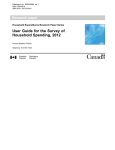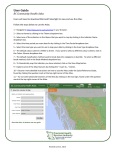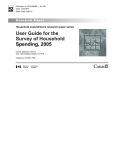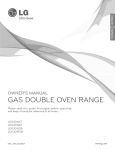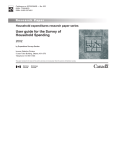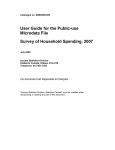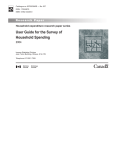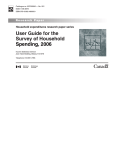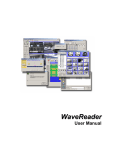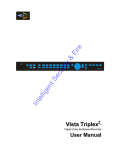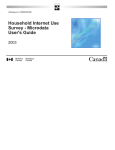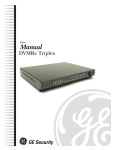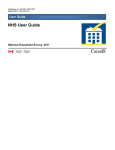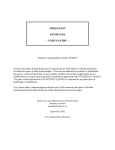Download User Guide for the Survey of Household Spending, 2011
Transcript
Catalogue no. 62F0026M, no. 1 ISSN 1708-8879 ISBN 978-1-100-21646-1 ..Research paper........................................................................ Household Expenditures Research Paper Series User Guide for the Survey of Household Spending, 2011 Income Statistics Division Telephone: 613-951-7355 How to obtain more information For more information about survey results and related products and services, contact Client Services (613-951-7355; 1-888-297-7355; fax 613-951-3012; [email protected]), Income Statistics Division. For information about this product or the wide range of services and data available from Statistics Canada, visit our website, www.statcan.gc.ca. You can also contact us by e-mail at [email protected] telephone, from Monday to Friday, 8:30 a.m. to 4:30 p.m., at the following toll-free numbers: • Statistical Information Service 1-800-263-1136 • National telecommunications device for the hearing impaired 1-800-363-7629 • Fax line 1-877-287-4369 Depository Services Program • Inquiries line • Fax line 1-800-635-7943 1-800-565-7757 To access this product This product, Catalogue no. 62F0026M, is available free in electronic format. To obtain a single issue, visit our website, www.statcan.gc.ca and browse by “Key resource” > “Publications.” Standards of service to the public Statistics Canada is committed to serving its clients in a prompt, reliable and courteous manner. To this end, this agency has developed standards of service that its employees observe. To obtain a copy of these service standards, please contact Statistics Canada toll-free at 1-800-263-1136. The service standards are also published at www.statcan.gc.ca under “About us” > “The agency” > “Providing services to Canadians.” Statistics Canada Income Statistics Division User Guide for the Survey of Household Spending, 2011 Published by authority of the Minister responsible for Statistics Canada © Minister of Industry, 2013 All rights reserved. Use of this publication is governed by the Statistics Canada Open License Agreement. http://www.statcan.gc.ca/reference/licence-eng.html January 2013 Catalogue no. 62F0026M, no. 1 ISSN 1708-8879 ISBN 978-1-100-21646-1 Frequency: Occasional Ottawa Cette publication est également disponible en français. Note of appreciation Canada owes the success of its statistical system to a long-standing partnership between Statistics Canada, the citizens of Canada, its businesses, governments and other institutions. Accurate and timely statistical information could not be produced without their continued cooperation and goodwill. User information Symbols The following standard symbols are used in Statistics Canada publications: . not available for any reference period .. not available for a specific reference period ... not applicable 0 true zero or a value rounded to zero 0s 2 value rounded to 0 (zero) where there is a meaningful distinction between true zero and the value that was rounded p preliminary r revised x suppressed to meet the confidentiality requirements of the Statistics Act E use with caution F too unreliable to be published * significantly different from reference category (p < 0.05) Statistics Canada – Catalogue no. 62F0026M, no. 1 Table of contents User Guide for the Survey of Household Spending, 2011 1 Introduction 4 2 Survey methodology 4 3 Data quality 10 4 Definitions 15 5 Derivation of data tables 22 6 Related products and services 28 7 References 28 Appendix I Diary’s response rates among the respondents to the interview 29 II Response rates by collection month 30 III Response rates by size of area of residence and by dwelling type 31 IV Diary’s response rates among the respondents to the interview, by various households’ characteristics 33 V Impact of expenditure imputation on communications services, cablevision, satellite distribution and security services 35 VI Imputation of dwelling characteristics and household equipment 36 VII Breakdown of the imputed expenditure codes by the initial level of the information from the respondent 37 VIII Imputation rates by method for recording the expenses in the diary 38 IX Estimated number of households and average household size by domain 39 Statistics Canada – Catalogue no. 62F0026M, no. 1 3 User Guide for the Survey of Household Spending, 2011 1 Introduction This guide presents information of interest to users of data from the 2011 Survey of Household Spending (SHS). It includes descriptions of the survey methodology and data quality, and definitions of survey terms and variables. There is also a section describing various statistics that can be drawn from the survey data. The SHS is conducted annually. The SHS combines a questionnaire with recall periods based on the type of expenditure (1, 3 or 12 months, last payment, four weeks) and a daily expenditure diary that the household completes for two weeks following the interview. As well, data collection is continuous throughout the year. The 2011 SHS was conducted from January 2011 to December 2011 using a sample of 17,873 households in the 10 provinces (the territories were not included in the 2011 survey). Detailed spending information was collected, as well as limited information on dwelling characteristics and household equipment. The method of adjusting for incomplete diaries has been refined with the 2011 SHS. As well, the age of household members is now defined to be at the time of the interview rather than as of December 31st of the survey year. To ensure comparability of the data, the 2010 data have also been revised by incorporating these changes. The revised 2010 estimate of average household spending on all types of goods and services has increased by 1.3% when compared with the previously published 2010 estimate (April 2012). Household expenditure estimates are available for the national and provincial levels and by household tenure, age of reference person, size of area of residence, type of household and household income quintile. Detailed estimates on food expenditures are also available. For custom tabulations or more information on the SHS, please contact (613-951-7355, 1-888-297-7355 or [email protected] ), Income Statistics Division. 2 2.1 Client Services Survey methodology The target population The target population of the 2011 SHS is the population of Canada’s 10 provinces, excluding residents of institutions, members of the Canadian Forces living in military camps and people living on Indian reserves. In all, these exclusions make up about 2% of the population of the 10 provinces. For operational reasons, people living in some remote areas where the rate of vacant dwellings is very high and where the collection cost would be exorbitant are excluded from collection. Also excluded, in addition to people living in institutions, are people living in other types of collective dwellings: • people living in residences for dependent seniors; and • people living permanently in school residences, hotels and motels, work camps, etc.; and • members of religious and other communal colonies. 4 Statistics Canada – Catalogue no. 62F0026M, no. 1 Household Expenditures Research Paper Series Collection exclusions make up less than 0.5% of the target population. However, these people are included in the population estimates to which the SHS estimates are adjusted (see section 2.6). 2.2 The survey content and reference periods The SHS primarily collects detailed information on household expenditures. It also collects information about the annual income of household members, demographic characteristics of the household, certain dwelling characteristics (e.g., type, age and tenure) and certain information on household equipment (e.g., electronics and communications equipment). For expenditure information collected with the questionnaire, the length of the reference period depends on the question (e.g., the past month, the past three months, or the past 12 months). The period covered also varies with the collection month (e.g., for households in the January 2011 sample, “the past 12 months” means the period from January 2010 to December 2010, while for households in the December 2011 sample, it refers to the months between December 2010 and November 2011). Expenditures collected in the daily expenditure diary are reported for a period of two weeks. In general, longer reference periods are used for goods and services that are more expensive or purchased infrequently or irregularly. On the contrary, shorter reference periods are used for goods and services that are of less value or purchased frequently or at regular intervals. For demographic characteristics, dwelling characteristics and household equipment, the reference period is the interview date. For income, the reference period is the calendar year preceding the survey year (i.e. 2010 for SHS 2011). 2.3 The sample design The sample of the 2011 Survey of Household Spending consists of 17,873 households spread over the 10 provinces. A stratified, multi-stage sampling plan was used to select the sample. It is generally a two-stage plan, the first stage being a sample of geographic areas (referred to as clusters). Then a list of all the dwellings in the selected clusters is prepared, and a sample of dwellings is selected. The selected dwellings that are inhabited by members of the target population constitute the survey’s sample of households. The SHS uses a number of components of the Labour Force Survey’s (LFS) sample design to minimize operating costs, though the dwellings selected are different. The national sample is first divided among the provinces on the basis of the variability of total household expenditures and, to a lesser extent, the number of households in each province. The goal is to obtain estimates of similar quality at the provincial level. The sample sizes for the provinces are shown in Table 1 in Section 3. The sample is then divided among the strata defined by grouping clusters with similar characteristics based on a number of socio-demographic variables. Some strata were defined to target specific subpopulations, such as the high-income household strata. To improve the quality of the estimates, the high-income household strata are allocated a larger share of the sample than the other strata, where an allocation proportional to stratum size is used. Since data are collected monthly, the sample is divided into 12 subsamples of similar size. During that process, the SHS sample is coordinated with the samples of the LFS and, to a lesser extent, the Canadian Community Health Survey (CCHS), which use the same sampling frame and conduct personal interviews for part of their sample. Coordination means that, wherever possible, if a cluster is selected for more than one survey, collection for the surveys will take place in the same month. This will enable the interviewer to become familiar with the neighbourhood, collect the data and carry out the necessary follow-up for more than one survey at a time. 2.4 Data collection The SHS is a voluntary survey. For the most part, the data are obtained directly from the respondent by combining two collection modes: a personal interview conducted by an interviewer using a questionnaire on a laptop, and a diary in Statistics Canada – Catalogue no. 62F0026M, no. 1 5 Household Expenditures Research Paper Series which the household is required to report its daily expenditures over a two-week period. The data were collected on a continuous basis from January to December 2011 from a sample of households spread over 12 monthly collection cycles. First, households in the sample are asked to complete a questionnaire that, for the most part, collects regular expenditures (such as rent and electricity) and less frequent expenditures (such as furniture and dwelling repairs) for a reference period that varies in length depending on the type of expenditure. For regular expenditures, the last-payment method is usually used. It involves collecting the amount of the last payment and the period it covered. For the other types of expenditures collected in the interview, reference periods of one month, three months or twelve months are generally used. The periods are defined in terms of months preceding the month of the interview. For example, for a household in the June sample, “the past three months” means the period from March 1 to May 31, 2011. The demographic characteristics, dwelling characteristics and household equipment, which are also collected in the interview, relate to the household’s situation at the time of the interview. In addition, respondents are asked to provide the income for the calendar year previous to the survey year for all household members aged 16 and over (at the time of the interview). However, respondents who give Statistics Canada permission to access their income tax returns are not required to answer the questions about personal income. Following the interview, respondents are asked to record the expenditures of all household members in a daily expenditure diary for a period of two weeks starting the day after the interview. Households are required to include all their spending, except a few types of expenditures, such as rent, regular utilities payments and real estate and vehicle purchases. Households have the option of providing receipts to reduce the amount of information recorded in the diary. However, they are asked to write out additional information on the receipt if the description is incomplete. Telephone follow-up is carried out a few days after the interview to find out if the respondent has any questions about the diary and to reiterate important information about how to complete it. At the end of the two-week period, the interviewer returns to the respondent’s residence to pick up the diary and ask a few additional questions to help the respondent report expenditures that he or she might have forgotten. The diaries and all receipts supplied by respondents are scanned and captured at Statistics Canada’s Head Office. An expenditure classification code is assigned to each item from a list of more than 600 different codes. 2.5 Data processing and quality control The computerized questionnaire contains many features designed to maximize the quality of the data collected. Many edits are built into the questionnaire to compare the reported data with unusual values and detect logical inconsistencies. When an edit fails, the interviewer is prompted to correct the information (with the respondent’s help, if necessary). Once the data are transmitted to Head Office, a comprehensive series of processing steps is undertaken for the purpose of detailed verification of each questionnaire. Invalid responses are corrected or flagged for imputation. A number of edits are also carried out on the diary data when the diaries are received at Head Office and throughout the capture and coding steps. For example, checks are carried out to ensure that the start and end dates of the reference period of the diary are indicated, that the reported expenditures were made during the specified reference period, and that there are no items that appear in both the data recorded in the diary and the receipts provided by the respondent. After validation, capture and coding, quality control procedures are applied. A sample of diaries is selected and completely rechecked to ensure that the diaries were captured and coded as specified in the procedures. Then a series of detailed edits are performed on all diaries. Invalid responses are corrected or flagged for imputation. The final step is to assess whether the information reported in the diaries is of sufficient quality using parameters which differ according to the household characteristics. The reported expenditures and number of items are compared with minimum thresholds estimated for each geographic area (Atlantic Provinces, Quebec, Ontario, Prairie Provinces and British Columbia), each household income class and each household size. Diaries that satisfy the conditions are deemed usable. The other diaries are examined. They will be deemed usable if there is a note explaining their low expenditures or their small number of reported items (for example a person living alone 6 Statistics Canada – Catalogue no. 62F0026M, no. 1 Household Expenditures Research Paper Series who had few expenses to report because he/she was on a business trip during the diary recording period). Diaries that do not meet the usability criteria are treated the same as non-response diaries; they are excluded from the estimates. It should be noted that some of the usable diaries are incomplete and could have non-responded days. To solve problems of missing or invalid information in interview questions, donor imputation by the nearest neighbour method is generally used. Data from another respondent with similar characteristics (the donor) are used to impute. The imputation is done on one group of variables at a time, with the groups formed on the basis of the relationships among the variables. The characteristics used to identify the donor are selected such that they are correlated with the variables to be imputed. Household income, dwelling type and number of adults and children are commonly used characteristics. For operational reasons, the income information from personal income tax returns is not available in time for imputation of the survey data. Consequently, the household income used for imputation is taken from an additional question on total household income that is asked during the interview exclusively for the purpose of data imputation. Donor imputation is also used when information is missing from the daily expenditure diary. A respondent may have reported a particular expenditure item without its cost or given the total amount spent (on groceries, for example) without listing the individual items. Imputation is also used to enhance the level of detail in coding the items reported. For example, the information provided by the respondent may simply indicate that a bakery product was purchased, but a more detailed code is required to meet the survey’s needs. In this case, donor imputation is used to impute the type of bakery product (bread, crackers, cookies, cakes and other pastries, etc.). Diary imputation is carried out at the reported item level, and the characteristics most often used to identify the donor are cost, available partial code, household income and household size. Imputation is done by province and quarter to control for provincial differences and seasonality of expenditures. Expenditure imputation is performed primarily with Statistics Canada’s Canadian Census Edit and Imputation System (CANCEIS). For personal income, people who give their consent are matched to the tax data file. Missing or invalid tax data are generally donor imputed. 2.6 Estimation The estimation of population characteristics from a sample survey is based on the premise that each sampled household represents a certain number of other households in addition to itself. This number is referred to as the survey weight, and the weighting process involves computing the weight assigned to each household. There are a number of steps in that process. First, each household is given an initial weight equal to the inverse of its selection probability. This weight is then adjusted to compensate for non-respondent households. Since a number of households answer the questionnaire but refuse to complete the diary, different weights are computed for the interview questionnaire and the diary. The interview weights are then adjusted so that selected survey estimates agree with aggregates or estimates from independent auxiliary sources. The first source is the number of persons by age group and the number of households by household size from population estimates produced by the Demography Division using data from the 2006 Census. Annual estimates of the number of persons in eight age groups (0–6, 7–17, 18–24, 25–34, 35–44, 45–54, 55–64 and 65+) are used at the provincial level and two age groups (0–17 and 18+) at the census metropolitan area level. For the number of households, the weights are calibrated to the annual provincial estimates for three household size categories (one, two, and three or more persons) and to quarterly provincial estimates of the total number of households. Quarterly estimates are used to ensure that each sub-annual period is adequately represented in the survey estimates. The second source is the Statement of Remuneration Paid (T4) data from the Canada Revenue Agency, which ensure that the survey’s weighted distribution of income (on the basis of wages and salaries) agree with the income distribution of the Canadian population. Interview weights are therefore calibrated to the T4 accounts of Statistics Canada – Catalogue no. 62F0026M, no. 1 7 Household Expenditures Research Paper Series the number of persons per province in six categories of wages and salaries on the basis of provincial percentiles (0th–25th, 25th–50th, 50th–65th, 65th–75th, 75th–95th and 95th–100th). The diary weights are adjusted to population estimates in the same way as the interview weights. They are also calibrated to the estimated number of households per income group by province calculated from the interview data. Specifically, the estimated number of households for each provincial quintile of total household income is used. The adjustment to the interview estimates ensures that the weighted income distribution of diary-respondent households is consistent with the weighted income distribution of interview-respondent households. All expenditure variables in the interview and diary are annualized by multiplying them by a factor appropriate for the reference period. For the diary, this factor includes as well an adjustment for the non-responded days. The estimates for a given expenditure category collected from the interview are therefore the weighted sums (using interview weights) of the annualized amounts. The estimates of an expenditure category derived from diary data are calculated in a similar manner using diary weights. Lastly, summary expenditure category estimates that include components from both collection methods are produced by taking the sum of the estimates of the diary and the interview components. This approach is used not only for aggregate spending estimates, but also for average expenditure per household (see section 5.2). 2.7 Reference period of the estimates With continuous monthly collection, the reference period of the data differs from one month to the other, as illustrated in Figure 1. For example, for an expenditure item with a three-month reference period, the data from the July sample covers expenditures made between April 1 and June 30, whereas the data from the December sample covers expenditures made between September 1 and November 30. Figure 1 Monthly sample reference periods of three different lengths Year previous to the survey year Survey year J F M A M J J A S O N D J F M A M J J A S O N D Twelve-month reference period Three-month reference period One-month reference period Collection period SHS estimates are produced by combining the data from the 12 monthly collection cycles and by annualizing the expenditures collected over various reference periods in order to standardize them. The period covered by the estimates is therefore a function of the length of reference period and of the collection months considered. 8 Statistics Canada – Catalogue no. 62F0026M, no. 1 Household Expenditures Research Paper Series When combining the data of the 12 collection cycles to generate estimates for expenditure items with short reference periods (e.g., one month), the expenditures that are covered occur mostly in the survey year. That is also true for all expenditure data collected with the diary. As for expenditure items with a 12-month reference period, the data collected include expenses occurring between January of the year before the survey year and November of the survey year, depending on the collection month. The hypothesis that the estimates produced from the SHS cover a single period when the data from 12 collection cycles has been combined assumes that expenditures made during the survey year and during the previous year are similar for items collected using a 12 month reference period. Thus, the validity of this hypothesis affects the interpretation of comparisons between expenditures collected over short periods and expenditures collected over a 12 month period. The “limits” of the collection model in producing expenditure estimates covering the same period (or the same year) are known since the majority of countries use this methodology. Despite any limitations, continuous collection with reference periods adapted to the ability of the respondent to provide the information is considered preferable in order to obtain data that reflects households’ true expenditures. 2.8 Historical revisions The method of adjusting for incomplete diaries has been refined with the 2011 SHS. As well, the age of household members is now defined to be at the time of the interview rather than as of December 31st of the survey year. To ensure comparability of the data, the 2010 data have also been revised by incorporating these changes. The revised 2010 estimate of average household spending on all types of goods and services has increased by 1.3% when compared with the previously published 2010 estimate (April 2012). The 2011 SHS estimates were computed with weights adjusted to 2011 population estimates. These population estimates were based on 2006 Census data and more recent information from administrative sources such as birth, death and migration registers. SHS estimates prior to 2010 (2001-2009) are based on weights calibrated to population estimates produced using data from the 2001 Census. There is no plan to revise theses estimates (based on the 2006 Census data) due to the break in the data series starting with the 2010 SHS (see section 2.9). 2.9 Comparability over time The SHS has been conducted each year since 1997. This survey includes most of the content of its predecessors, the periodic Family Expenditure Survey and the Household Facilities and Equipment Survey. Some changes to the methodology and definitions were made between 1997 and 2009, but the SHS was primarily based on an interview during the first quarter of the year in which households reported expenditures incurred in the preceding calendar year. A new methodology which combines a questionnaire and a diary to collect the household expenditures was introduced for the 2010 survey. The reference periods have been reduced for many expenditure items and collection is continuous throughout the year. Although the expenditure data collected since 2010 are similar to those of previous years, the changes to data collection, processing and estimation methods have created a break in the data series. As a result, caution should be used in comparing SHS data since 2010 with previous years, unless otherwise noted. Since 2010, the SHS incorporates a significant amount of content from the Food Expenditure Survey (FES), last conducted in 2001. Although there are some differences between the SHS and FES methodologies, food expenditure data in both surveys have been collected using a daily expenditure diary that households are asked to fill in for a period of two weeks. The content of the SHS diary is slightly less detailed than that of the FES diary (e.g., the weight and quantity of foods are not collected) to limit the SHS respondent’s burden. Statistics Canada – Catalogue no. 62F0026M, no. 1 9 Household Expenditures Research Paper Series The content of the SHS has also been reviewed in 2010 to reduce the time required for the interview. A number of components regarding household equipment and dwelling characteristics and most of the questions regarding changes in household assets and liabilities have been dropped. Some definitions have also been changed. As well, starting with the 2010 survey, the data related to household income and income tax come mainly from an administrative data source. Finally, the 2010 and 2011 estimates are based on weights calibrated to population estimates produced using data from the 2006 Census. Estimates in previous years (2001-2009) are based on weights calibrated to population estimates produced using data from the 2001 Census. 3 Data quality Like all surveys, the SHS is subject to error, despite all the precautions taken in each step of the survey to prevent them or reduce their impact. There are two types of error: sampling and non-sampling. 3.1 Sampling errors Sampling errors occur because inferences about the entire population are based on information obtained from only a sample of the population. The sample design, estimation method, sample size and data variability determine the size of the sampling error. The data variability for an expenditure item is the difference between members of the population in spending on that item. In general, the greater the differences between households, the larger the sampling error will be. A common measure of sampling error is the standard error (SE). The SE is the degree of variation in the estimates as a result of selecting one particular sample over another. The SE expressed as a percentage of the estimate is called the coefficient of variation (CV). The CV is used to indicate the degree of uncertainty associated with an estimate. For example, if the estimated number of households having a given dwelling characteristic is 10,000 with a CV of 5%, then the actual number is between 9,500 and 10,500 households 68% of the time, and between 9,000 and 11,000 households 95% of the time. The standard errors for the SHS are estimated using the bootstrap method (see reference [1] in section 7). CVs are available for the national and provincial estimates as well as for the estimates by household type, age of reference person, household income quintile, household tenure and size of area of residence. 3.2 Data suppression To ensure accuracy, we want to suppress the estimates for which the CVs have been estimated at more than 33%. However, from an operational standpoint, when tables are created, the suppression rule is based on the number of households that declare an expense for an item. Indeed, there is a relationship between the CV and the number of reporting households, and analyses carried out on a very large number of SHS estimates show that a threshold of 30 reporting households generally allows for a CV of at most 33% for the expenditure estimates. However, data for suppressed items do contribute to summary level variables. For example, the expenditure estimate for a particular item of clothing might be suppressed but this amount is included in the total estimate for clothing expenditure. 3.3 Non-sampling errors Non-sampling errors occur because certain factors make it difficult to obtain accurate responses or responses that retain their accuracy throughout processing. Unlike sampling errors, non-sampling errors are not readily quantified. Four sources of non-sampling error can be identified: coverage error, response error, non-response error and processing error. 10 Statistics Canada – Catalogue no. 62F0026M, no. 1 Household Expenditures Research Paper Series 3.3.1 Coverage error Coverage error arises when sampling frame units do not adequately represent the target population. This error may occur during sample design or selection, or during data collection or processing. 3.3.2 Response error Response error occurs when respondents provide inaccurate information. This error may be due to many factors, including faulty design of the questionnaire, misinterpretation of questions by interviewers or respondents, or faulty reporting by respondents. In general, the accuracy of SHS data depends largely on respondents’ ability to remember (recall) household expenditures and their willingness to consult records. Response error is the most difficult aspect of data quality to measure. 3.3.3 Non-response error Errors due to non-response occur when potential respondents do not provide the required information or the information they provide is unusable. The main impact of non-response on data quality is that it can cause a bias in the estimates if the characteristics of respondents and non-respondents differ and the difference has an impact on the expenditures studied. While non-response rates can be calculated, they provide only an indication of data quality, since they do not measure the bias associated with the estimates. The magnitude of non-response can be considered a simple indicator of the risks of bias in the estimates. For the 2011 SHS, the interview response rate is 65.7%, and provincial response rates are shown in Table 1. The table also shows the number of non-responding households by reason for non-response. Reasons include the inability to contact the household, the household’s refusal to participate in the survey and the inability to hold an interview because of special circumstances (e.g., the respondent speaks neither official language or has a physical condition that precludes an interview). Text table 1 Interview’s response rates, Canada and provinces, 2011 Eligible sampled households No contacts Refusals Residual non-respondents Respondents number Canada Atlantic provinces Newfoundland and Labrador Prince Edward Island Nova Scotia New Brunswick Quebec Ontario Prairie provinces Manitoba Saskatchewan Alberta British Columbia 17,873 5,525 1,410 736 1,724 1,655 2,370 2,678 5,241 1,753 1,503 1,985 2,059 1,665 435 103 44 107 181 175 279 550 206 131 213 226 Response 1 rate percentage 3,825 1,107 266 150 422 269 560 678 1,053 349 260 444 427 637 237 51 30 74 82 61 121 152 74 17 61 66 11,746 3,746 990 512 1,121 1,123 1,574 1,600 3,486 1,124 1,095 1,267 1,340 65.7 67.8 70.2 69.6 65.0 67.9 66.4 59.7 66.5 64.1 72.9 63.8 65.1 1. (Respondent households/Eligible sampled households) x 100. Some of the interview respondents did not complete a diary, or the diary they provided was considered unusable under the criteria set out in section 2.5. For the 2011 SHS, the diary response rate of interview respondents is 65.2%, and provincial rates are given in Appendix I. The final diary response rate is 42.9% nationally, and provincial rates are shown in Table 2. Statistics Canada – Catalogue no. 62F0026M, no. 1 11 Household Expenditures Research Paper Series Text table 2 Diary’s response rates, Canada and provinces, 2011 Eligible 1 sampled households Interview 2 non-respondents Diaries Refusal 3 Unusable Usable number Canada Atlantic provinces Newfoundland and Labrador Prince Edward Island Nova Scotia New Brunswick Quebec Ontario Prairie provinces Manitoba Saskatchewan Alberta British Columbia 1. 2. 3. 4. 17,873 5,525 1,410 736 1,724 1,655 2,370 2,678 5,241 1,753 1,503 1,985 2,059 6,127 1,779 420 224 603 532 796 1,078 1,755 629 408 718 719 Response 4 rate percentage 3,704 1,031 259 159 341 272 461 546 1,142 351 378 413 524 381 142 43 15 47 37 46 81 82 24 29 29 30 7,661 2,573 688 338 733 814 1,067 973 2,262 749 688 825 786 42.9 46.6 48.8 45.9 42.5 49.2 45.0 36.3 43.2 42.7 45.8 41.6 38.2 The eligible sampled households are the same for the interview and the diary. Includes interview "No contacts", "Refusals" and "Residual non-respondents". The definition of usable and unusable diaries is given in the "Data processing and quality control" Section. (Usable diaries/Eligible sampled households)x100. The response rate varies from month to month. Monthly response rates for the interview and diary can be found in Appendix II. Interview and diary response rates by size of area of residence and dwelling type can be found in Appendix III. The diary response rate of interview respondents can be found in Appendix IV, broken down by various households’ characteristics, including household type, household tenure, age of the reference person and before-tax income quintile. Cases in which the respondent fails to answer some of the questions are referred to as partial non-response. Imputing missing values compensates for this partial non-response. Imputation rates are described in section 3.3.5. There are also cases in which a household fails to complete the diary for all 14 days as required, leaving days with no data. Adjustment factors were thus calculated to take into consideration these days with no data. 3.3.4 Processing error Processing errors may occur in any of the data processing stages, including data entry, coding, editing, imputation of partial non-response, weighting and tabulation. Steps taken to reduce processing error are described in section 2.5. 3.3.5 Imputation of partial non-response The residual bias remaining after the imputation of partial non-response is difficult to measure. It depends on the imputation method’s ability to produce unbiased estimates. The imputation rates provide an indication of the magnitude of partial non-response. Partial interview non-response may result from a lack of information or an invalid response to a question. The national and provincial percentages of households for which certain categories of expenditures had to be imputed because of partial interview non-response is shown in Table 3, by number of imputed expenditure variables per household (out of all consumer expenditure data collected during the interview). The table contains two series of results, including and excluding expenditures on communications services (telephone, cell phone and Internet), and cablevision, satellite distribution and security system services. This distinction has been made because those services are increasingly being purchased as a package. Households are often billed for bundled services, making it difficult or impossible to provide separate expenditure data for each service. Therefore, the total amount paid 12 Statistics Canada – Catalogue no. 62F0026M, no. 1 Household Expenditures Research Paper Series for the package is allocated to individual services through imputation, which significantly increases the number of households for which expenditures must be imputed. Text table 3 Percentage of households requiring imputation for consumer expenses collected during the interview, Canada and provinces, 2011 Number of variables imputed 1 2 to 9 1 (out of 170) 10 or more Number of variables imputed Total 2 (out of 176) 1 2 to 9 10 or more Total 10.5 7.8 9.4 8.3 10.8 11.9 12.9 10.6 9.9 10.6 10.4 63.3 66.0 70.3 71.9 54.8 66.9 57.4 58.7 65.5 62.0 65.2 3.5 1.5 2.1 2.2 2.5 2.2 3.4 8.2 5.5 3.4 3.5 77.4 75.3 81.8 82.4 68.0 81.1 73.7 77.5 80.8 75.9 79.2 percentage Canada Newfoundland and Labrador Prince Edward Island Nova Scotia New Brunswick Quebec Ontario Manitoba Saskatchewan Alberta British Columbia 23.1 21.6 26.8 22.7 21.3 27.3 24.3 18.5 23.4 21.2 23.6 27.8 24.6 21.1 31.0 24.0 29.9 26.1 32.0 29.0 31.3 25.0 2.2 0.5 2.0 0.5 1.5 1.5 2.3 5.8 3.6 2.0 2.2 53.1 46.8 49.8 54.1 46.8 58.6 52.7 56.3 56.0 54.5 50.8 1. Excluding expenditures related to communications services, and services for cablevision, satellite distribution and security systems. 2. Including expenditures related to communications services, and services for cablevision, satellite distribution and security systems. Users of expenditure estimates relating to communications services, and cablevision, satellite television and security system services should therefore take into account the high level of imputation of the expenditure data if they are examining individual services rather than the combined totals. A measure of the impact of imputation on each individual service has been produced and is discussed in Appendix V. This measure represents the proportion of the total value of the estimate obtained from imputed data. The percentages of households that responded to the interview and for which dwelling characteristics or household equipment had to be imputed can be found in Appendix VI. The imputation rates for all expenditures reported in the expenditure diary are shown in tables 4 and 5. Table 4 deals with expenditures reported in the first section of the diary, for food from stores and other goods and services. Table 5 shows the imputation rates for the second section of the diary, on expenses from restaurants. For expenditure data from the diaries, imputation is used primarily to assign a value when the amount of a reported expenditure is missing, to assign a list of expenditure items (with individual costs) when only the total cost was provided (e.g., to assign grocery items and their individual cost when the respondent has provided only the total amount of the bill) or to assign an expenditure code that is more detailed than the one that could be assigned using the information from the respondent (e.g., the type of bakery product). The imputation rate for each of these three types of imputation is shown in Table 4. Each rate represents the proportion of imputed items out of all the expenditure items from the diaries. Statistics Canada – Catalogue no. 62F0026M, no. 1 13 Household Expenditures Research Paper Series Text table 4 Imputation rates by type of imputation for the section of the diary on Food from stores and other goods and services, Canada, 2011 Type of imputation Imputation rate percentage Imputation of a missing cost for a reported expense Food from stores Other goods and services All expenditures Imputation of expenditure items (and their individual cost) from a total expense Food from stores Other goods and services All expenditures Imputation of detailed expenditure code Food from stores Other goods and services All expenditures 1.5 2.3 1.7 17.3 12.4 15.6 7.2 7.1 7.1 The risks of bias associated with the imputed data depend largely on the level of detail at which the SHS data are used. For example, food expenditure data in the SHS are produced at a high level of detail to meet the needs of the Food Expenditure Survey users (last conducted in 2001). Food expenditures are categorized using a hierarchical system of more than 200 expenditure codes. For some reported expenditure items, the food product may have been known (e.g., dairy products or even milk), but the level of detail required (e.g., skim milk, 1% milk or 2% milk) had to be imputed. This type of imputation gives rise to a risk of bias only in expenditure estimates at a very detailed level. In other cases, however, almost no information on the type of expenditure was available before imputation (e.g., it was known only that the expenditure was for a good). When so little information is available, the risks of bias in the estimates of the expenditure categories are more significant. Additional results regarding the imputation of expenditure codes that are more detailed can be found in Appendix VII, which contains a breakdown of the imputed expenditure codes by the initial level of the information from the respondent. Restaurant expenditures are reported using a slightly different format in the second section of the diary. Imputation is used primarily to assign a value when the total amount of the restaurant expenditure or the cost of alcoholic beverages is missing, or when the type of meal (breakfast, lunch, dinner or snack and beverage) has not been specified. The imputation rate for each of these three types of imputation is shown in Table 5. Text table 5 Imputation rates by type of imputation for the section of the diary on Snacks, beverages and meals purchased from restaurants or fast-food outlets, Canada, 2011 Type of imputation Imputation rate percentage Imputation of total cost Imputation of costs for alcoholic beverages 1 Imputation of meal type (breakfast, lunch, dinner or snack and beverages) 0.83 2.04 8.26 1. The higher imputation rate observed in 2011 is for the most part due to a change made in the imputation methodology for this variable. Some restaurant expenses are incorrectly reported in the section of the diary on Food from stores and other goods and services. During the diaries’ editing stage, these items are moved to the section of the diary on Snacks, beverages and meals purchased from restaurants or fast-food outlets. Those items among them having a total cost greater than ten dollars are now subject to the possibility of imputing an amount for alcohol following the observed distribution of restaurant items with alcohol reported. Lastly, households have the option of providing receipts or recording their expenditure information in the diary. Table 6 shows the percentage of expenditures reported using each method, for food expenditures, restaurant expenditures and other goods and services. 14 Statistics Canada – Catalogue no. 62F0026M, no. 1 Household Expenditures Research Paper Series Text table 6 Methods for recording expenses in the diary, Canada, 2011 Expenditure category Transcriptions Receipts percentage Food Restaurant Other goods and services 23.7 87.5 47.8 76.3 12.5 52.2 Imputation rates vary depending on the expenditure reporting method. The rates in tables 4 and 5 are shown by the expenditure reporting method in Appendix VIII. 3.4 The effect of large values For any sample, estimates of totals, averages and standard errors can be affected by the presence or absence of large values in the sample. Large values are more likely to arise from positively skewed populations. Such values are found in the SHS and are taken into account when the final estimates are generated. 4 Definitions 4.1 General concepts 4.1.1 Reference year of the survey Corresponds to the data collection year, from January 1st to December 31st, 2011. 4.1.2 Household A person or group of persons occupying one dwelling unit is defined as a “household”. The number of households, therefore, equals the number of occupied dwellings. 4.1.3 Household member A person usually residing in the dwelling unit at the time of the interview. 4.1.4 Reference person The household member being interviewed chooses which household member should be listed as the reference person after hearing the following definition: “The household reference person is the member of the household mainly responsible for its financial maintenance (e.g., pays the rent, mortgage, property taxes, and electricity). When members of the household share the responsibility equally, choose one of these members to be shown as the reference person”. This person must be a member of the household at the time of the interview. 4.1.5 Expenditures The net cost of all goods and services received for private use within a given period (for example, 1, 3 or 12 months), whether or not the goods or services were paid for during that period, and regardless of whether these expenditures were made in Canada or abroad. Business expenditures are excluded. Statistics Canada – Catalogue no. 62F0026M, no. 1 15 Household Expenditures Research Paper Series 4.1.6 Taxes included All expenditures include the Goods and Services Tax, provincial retail sales taxes, tips, customs, duties and any other additional charges or taxes. 4.1.7 Gifts Any expenditure may include gifts given to persons outside the household. Only the value of gifts of clothing is reported separately. 4.1.8 Insurance settlements Where an insurance settlement was used to repair or replace property, the survey includes only the deductible amount paid for an item. 4.1.9 Trade-ins Where a trade-in is used to lower the price of an item, most commonly a vehicle, the expenditure amount is the total cost after the trade-in. Real estate transactions are excepted. 4.2 Household characteristics 4.2.1 Number of households in sample Corresponds to the number of eligible sample households minus households that interviewers were unable to contact, households that refused to participate and households whose interview questionnaire were rejected for lacking too much information. 4.2.2 Estimated number of households Estimation of the average number of households during the reference year. 4.2.3 Household size Number of persons in the household at the time of the interview. 4.2.4 Age of reference person Corresponds to the age of the reference person at the time of the interview. 4.2.5 Household income before tax Corresponds to the total income before tax received by the household the year prior to the reference year of the survey. It refers to income from all sources including government transfers: scholarships, bursaries and fellowships, wages and salaries before deductions, farm self-employment net income, non-farm self-employment net income, universal child care tax benefit, Old Age Security pension, CPP and QPP benefits, Employment Insurance benefits, social assistance, workers’ compensation benefits, Federal GST/HST Credit, provincial tax credits, other government transfers, private retirement pensions, support payments received, other taxable income and income from a RDSP and investment income. 4.2.6 Homeowner Household living in a dwelling owned (with or without a mortgage) by a member of the household at the time of the interview. 16 Statistics Canada – Catalogue no. 62F0026M, no. 1 Household Expenditures Research Paper Series 4.3 Selected household expenditures 4.3.1 Total expenditure The sum of total current consumption, income taxes, personal insurance payments and pension contributions, and gifts of money, alimony and contributions to charity. 4.3.2 Total current consumption Sum of the expenditures for food, shelter, household operations, household furnishings and equipment, clothing and accessories, transportation, health care, personal care, recreation, education, reading materials and other printed matter, tobacco products and alcoholic beverages, games of chance, and miscellaneous expenditures. 4.3.3 Food purchased from stores “Stores” includes all establishments where food can be bought, such as grocery stores, specialty food stores, department stores, warehouse-type stores and convenience stores, but also frozen food suppliers, outdoor farmers’ markets and stands, and all other non service establishments. The expenditures are net of cash premium vouchers or rebates at the cash register and include deposits paid for at the time of purchase. These deposits are excluded from the expenditures when reimbursed and are shown as negative expenditures (flow of money in) in the “Miscellaneous expenditures” section. 4.3.4 Food purchased from restaurants “Restaurants” includes full service restaurants, fast-food outlets, cafeterias, but also refreshments stands, snack bars, vending machines, mobile canteens, caterers and chip wagons. Includes tips. Does not include expenditures for alcoholic beverages. 4.3.5 Shelter Principal accommodation (either owned or rented) and other accommodation such as vacation homes or accommodation while travelling. 4.3.6 Rent Net rent, excluding rent paid for business, or rooms rented out. Includes additional amounts paid to landlord. 4.3.7 Tenants’/Homeowners’ insurance premiums Premiums paid for fire and comprehensive policies. 4.3.8 Repairs and maintenance (owned living quarters) Covers expenditures for labor and materials for all types of repairs and maintenance, including expenditures to repair and maintain built-in equipment, appliances and fixtures. Expenditures related to alterations and improvements are excluded as they are considered as an increase in assets (investment) rather than an expense. 4.3.9 Water, fuel and electricity (for principal accommodation) Expenditures for services related to water and sewage, electricity, and natural gas and other fuel for the principal accommodation, whether rented or owned. Statistics Canada – Catalogue no. 62F0026M, no. 1 17 Household Expenditures Research Paper Series 4.3.10 Property taxes and sewage charges (for owned vacation homes and other secondary residences) Refers to the amount billed, excluding any rebates. Special service charges (e.g., garbage, sewage), local improvements, and water charges are included if these are part of the property tax bill. 4.3.11 Accommodation away from home Includes all expenses for accommodation while travelling. Excludes expenditures for accommodation that were part of a package trip. 4.3.12 Household appliances Refers to the net purchase price after deducting trade-in allowance and any discount. Excludes appliances included in the purchase of a home. 4.3.13 Purchase of automobiles, vans and trucks Refers to the net purchase price, including extra equipment, accessories, and warranties bought when the vehicle was purchased, after deducting any trade-in allowance or separate sales. Separate sales occur when a vehicle is sold independently by the owner, e.g., not traded in when purchasing or leasing another vehicle. 4.3.14 Health care Includes direct costs to household (out-of-pocket) net of the expenditures reimbursed, and health insurance premiums. 4.3.15 Package trips Includes at least two components such as transportation and accommodation, or accommodation with food and beverages. 4.3.16 Tobacco products and smokers’ supplies Includes cigarettes, tobacco, cigars, matches, pipes, lighters, ashtrays, cigarette papers and tubes, and other smokers’ supplies. 4.3.17 Alcoholic beverages Includes alcoholic beverages purchased from stores and restaurants. Expenditures on supplies and fees for self-made beer, wine or liquor are also included. 4.3.18 Games of chance Expenditures on all types of games of chance. The expenditures are not net of the winnings from these games. 4.3.19 Discounts and refunds Presented in the data tables as “negative expenditures” since they represent a flow of money into the household instead of out of it. 18 Statistics Canada – Catalogue no. 62F0026M, no. 1 Household Expenditures Research Paper Series 4.3.20 Income taxes The sum of federal and provincial income taxes payable for the taxation year prior to the reference year of the survey. Income taxes include taxes on income, capital gains and RRSP withdrawals, after taking into account exemptions, deductions, non-refundable tax credits, and the refundable Quebec abatement. 4.4 Dwelling characteristics 4.4.1 Type of dwelling Type of dwelling in which the household resided at the time of interview. A dwelling is a structurally separate set of living premises with a private entrance from outside the building or from a common hall or stairway. – A single detached dwelling contains only one dwelling unit and is completely separated by open space on all sides from any other structure, except its own garage or shed. – A single attached dwelling is a double or semi-detached unit (side-by-side) or a row or terrace unit. – Apartment includes duplexes (two dwellings, situated one above the other), triplexes, quadruplexes and apartment buildings. – Other dwellings include mobile homes, motor homes, tents, railroad cars or houseboats, which are used as permanent residences and are capable of being moved on short notice. 4.4.2 Repairs needed Indicates the respondent’s perception of the repairs the dwelling needed at the time of the interview to restore it to its original condition. Remodelling, additions, conversions, or energy improvements that would upgrade the dwelling over and above its original condition are not included. – Major repairs include serious deficiencies in the structural condition of the dwelling, as well as the plumbing, electrical and heating systems. Examples include corroded pipes, damaged electrical wiring, sagging floors, bulging walls, damp walls and ceilings, and crumbling foundation. – Minor repairs include deficiencies in the surface or covering materials of the dwelling and less serious deficiencies in the plumbing, electrical and heating systems. Examples include small cracks in interior walls and ceilings, broken light fixtures and switches, cracked or broken panes, leaking sinks, missing shingles or siding, and peeling paint. 4.4.3 Tenure Housing status of the household at the time of the interview. – Owned with mortgage indicates that the dwelling was owned by a household member and that there was a mortgage at the time of the interview. – Owned without mortgage indicates that the dwelling was owned by a household member and that there was no mortgage at the time of the interview. – Rented indicates that the dwelling was rented by the household or occupied rent-free at the time of the interview. 4.4.4 Number of bathrooms (for dwelling occupied at the time of the interview) Number of rooms in the dwelling with an installed bathtub and/or shower. Statistics Canada – Catalogue no. 62F0026M, no. 1 19 Household Expenditures Research Paper Series 4.5 Household equipment 4.5.1 Telephone (includes business use) Includes telephones used for business if the business is conducted in the dwelling. Cordless phones are also included. 4.5.2 Cellular telephone Includes cellular telephones and handheld text messaging devices with cell phone capability. 4.5.3 Compact disc player A compact disc player may be a separate unit, part of a component or built in (as in a receiver/cassette recorder/compact disc combination unit). 4.5.4 Home computer Excludes computers used exclusively for business purposes. 4.5.5 Internet use from home Indicates whether the household has access to the Internet at home. 4.5.6 Owned vehicles Number of vehicles (automobiles, vans and trucks) owned by members of the household at the end of the month prior to the time of the interview. 4.6 Classification categories 4.6.1 Canada Canada-level data for 2011 include the 10 provinces only. 4.6.2 Province/territory No data for the territories for 2011. 4.6.3 Before-tax household income quintile (national) Income groupings are obtained by ranking the households responding to the interview in ascending order by the total income before tax of the households, then partitioning the households into five groups of similar size. The estimated number of households in each group should be the same in principle but differences may occur due to the weight of the household at the boundary of two quintiles, since this household must lie in either one or the other of these quintiles. Moreover, the specific methodology of the survey (with a series of weights for the interview and another series for the diary) ensures that the same estimate of the number of households for the interview and the diary will occur only if the quintiles are defined at the provincial level. For the national quintiles, there may be a difference between the estimate of the number of households based on either the interview weights or the diary weights. (See section 5 “Derivation of data tables”.) 4.6.4 Housing tenure Whether a household member owned or rented the dwelling in which the household lived at the time of the interview. 20 Statistics Canada – Catalogue no. 62F0026M, no. 1 Household Expenditures Research Paper Series – Owners refers to all households living in a dwelling owned (with or without mortgage) by a household member at the time of the interview. – Owners with mortgage owned the dwelling with a mortgage at the time of the interview. – Owners without mortgage owned the dwelling without a mortgage at the time of the interview. – Renters rented a dwelling at the time of the interview (as a regular tenant, rent free, or with reduced rent) 4.6.5 Household type Households are divided according to the following types: – One person households are the households where the dwelling is occupied by only one person at the time of the interview. – Couple households are households where the married or common law spouse of the reference person is a member of the household at the time of the interview. This household type may be further broken down into couple households without children (without additional persons), with children (without additional persons), and with additional persons. “Children” are never-married sons, daughters, or foster children of the reference person and may be any age. “Additional persons” include sons, daughters and foster children whose marital status is other than “single, never-married”, other relatives by birth or marriage, and unrelated persons. – Lone-parent households are households where the reference person has no spouse at the time of the interview and there is at least one child (never-married son, daughter, or foster child of the reference person). The lone-parent households for which data are presented do not include any additional persons. – Other households are households composed of relatives only or households having at least one household member who is unrelated to the reference person (e.g., lodger, roommate, employee). Relatives may include: • son, daughter, or foster child of the reference person whose marital status is other than single, never-married; • relatives of the reference person by birth or marriage (not spouse, son, daughter or foster child). 4.6.6 Size of area of residence Sampled dwellings are assigned to the following groups depending on the area in which they are located according to the 2006 Census boundaries and population size. Population centres 1,000,000 and over 500,000 to 999,999 250,000 to 499,999 100,000 to 249,999 30,000 to 99,999 1,000 to 29,999 Rural Statistics Canada – Catalogue no. 62F0026M, no. 1 21 Household Expenditures Research Paper Series 4.6.7 Population centre Area with a population of at least 1,000 or more and a density of 400 or more people per square kilometre. Population centres are classified as either small, medium, or large as defined below: • Small population centre: 1,000 to 29,999 • Medium population centre: 30,000 to 99,999 • Large urban population centre: 100,000 and over 4.6.8 Rural area All areas outside population centres are considered rural. Taken together, population centres and rural areas cover all of Canada. 4.6.9 Age of reference person Households are grouped according to the age the reference person as the following: – Less than 30 years – 30 to 39 years – 40 to 54 years – 55 to 64 years – 65 years and over 5 Derivation of data tables This section explains how the SHS data tables have been derived. It then explains the calculations used most frequently to manipulate the data. Users are advised to refer to this section before doing their data analysis. As stated above, SHS respondents must complete a questionnaire and a daily expenditure diary. However, some of them do not complete a diary for various reasons (e.g., refusal). Therefore, different weights are calculated for the interview questionnaire and diary, resulting in the use of two sets of weights, which makes using the data more complicated. 5.1 Estimates of number of households Estimates are generated using two sets of weights, one for the interview and the other for the diary. Adjustments made during weighting ensure that the estimate of the number of households at the provincial level using either set of weights is equivalent for the following domains: – household sizes of one, two, or three or more persons; and – household income groups defined according to provincial quintiles. By default, the estimate of the number of households for any aggregation of these domains also results in equivalent estimates. For any other domain, an estimate of the number of households may differ somewhat depending on the reliability of these estimates. The estimate of the number of households in the SHS tables has been produced using interview weights, as opposed to diary weights. The average household size is also produced from the interview weights. 22 Statistics Canada – Catalogue no. 62F0026M, no. 1 Household Expenditures Research Paper Series The estimated number of households and the average household size of the various domains for which estimates are produced in CANSIM tables are available in Appendix IX. 5.2 Estimates of average expenditure per household Estimates using both interview and diary expenditure data are produced in two steps: estimates are produced separately from the interview and the diary, and then they are added together. For average expenditure per household, the interview average expenditure per household is calculated using the weighted sum of expenditure data obtained from the interview divided by the sum of the interview weights. Similarly, the diary average expenditure per household is estimated using the weighted sum of expenditure data obtained from the diary divided by the sum of the diary weights. The two components are then added to obtain the average expenditure per household. With this approach, the combined interview and diary average expenditure per household does not exactly match the combined interview and diary weighted sum of expenditure divided by the estimated number of households (produced using the interview weights) for domains in which the interview and diary estimates do not match. Nevertheless, the approach ensures that the sum of the average expenditure per household for all categories equals the total average expenditure per household. 5.3 Examples of expenditure estimates The tables in this section contain examples of expenditure estimates produced separately from interview and from diary data, as well as an example of expenditure estimates where interview and diary data have to be combined. 5.3.1 Examples of expenditure estimates obtained from interview data The CANSIM tables include estimates of average expenditure per household. For technical reasons, the estimated number of households and the average household size are not included in these tables but are provided in Appendix IX. In this document, we present an example of the estimated number of households in Table 7 associated with estimates of average expenditure per household from Table 8 in order to help in the understanding of the subsequent examples. Text table 7 Estimated number of households based on interview weights, by household tenure All households Owner with mortgage Owner without mortgage Renter 4,219,949 4,481,247 number Estimated number of households 13,514,009 4,812,813 Statistics Canada – Catalogue no. 62F0026M, no. 1 23 Household Expenditures Research Paper Series Text table 8 Average household expenditures obtained from interview data, by household tenure All households Owner with mortgage Owner without mortgage Renter dollars Shelter Household furnishing and equipment Clothing and accessories Transportation 5.3.2 15,210 23,712 9,643 11,320 2,027 3,360 11,229 2,699 4,289 14,505 2,235 3,268 12,389 1,115 2,448 6,638 Examples of expenditure estimates obtained from diary data Text table 9 Estimated number of households based on diary weights, by household tenure All households Owner with mortgage Owner without mortgage Renter 4,214,778 4,513,374 number Estimated number of households 13,514,009 4,785,857 Text table 10 Average household expenditures obtained from diary data, by household tenure All households Owner with mortgage Owner without mortgage Renter dollars Food expenditures Food purchased from stores Food purchased from restaurant 5.3.3 7,795 5,588 9,234 6,583 8,465 6,053 5,642 4,098 2,207 2,652 2,412 1,544 Examples of estimates obtained from both interview and diary expenditure data In Table 11, we present the estimated number of households and the average household size as provided in Appendix IX, while Table 12 represents a typical example of an average household expenditures table available to users. 24 Statistics Canada – Catalogue no. 62F0026M, no. 1 Household Expenditures Research Paper Series Text table 11 Estimated number of households and average household size based on interview weights, by household tenure All households Owner with mortgage Owner without mortgage Renter 4,219,949 2.30 4,481,247 2.05 number Estimated number of households Average household size 13,514,009 2.48 4,812,813 3.03 Text table 12 Average household expenditures obtained from interview and diary data, by household tenure All households Owner with mortgage Owner without mortgage Renter dollars Total expenditure 1 Food expenditures Food purchased from stores Food purchased from restaurant Shelter Household furnishing and equipment Clothing and accessories Transportation 39,621 7,795 5,588 54,439 9,234 6,583 36,000 8,465 6,053 27,163 5,642 4,098 2,207 15,210 2,652 23,712 2,412 9,643 1,544 11,320 2,027 3,360 11,229 2,699 4,289 14,505 2,235 3,268 12,389 1,115 2,448 6,638 1. Total of expenditure for the categories used in this example. Tables 7 to 10 above are not available to users; however, the following section provides examples on how to produce other estimates using tables such as 11 and 12 above. 5.4 Calculating various estimates using the tables The following section explains the calculation method for some of the common SHS expenditure data manipulations. 5.4.1 How to calculate average expenditures per person To calculate average expenditure per person for a given category, divide the average expenditure per household for that category (Table 12) by the average household size (found on the second line of Table 11). For example, the average food expenditure per person for renter households is calculated as follows: Average food expenditure per person for renter households = Average food expenditure per renter household Average size of renter households Example : $5,642 2.05 = $2,752 When comparing estimates of average expenditure per person, note that household composition (number of children and adults) is a significant factor in many expenditure patterns. Statistics Canada – Catalogue no. 62F0026M, no. 1 25 Household Expenditures Research Paper Series 5.4.2 How to calculate percentages of total average household expenditure (budget shares) To calculate the budget share of an individual expenditure category as a percentage of total average household expenditure, divide the average expenditure per household for that expenditure category by the total average expenditure per household, and then multiply by 100. For example, using the Table 12, the percentage of total average expenditure per household represented by the average expenditures on food per household, for renter households, is calculated as follows: Percentage of total average expenditure per household represented by the average expenditures on food per household, for renter households = Average expenditure on food per renter household Total average expenditure per renter household Example : 5.4.3 $5,642 x 100 $27,163 x 100 = 20.77% Combining expenditure categories into your own groupings The average expenditure per household for different expenditure categories can be added together to make new subtotals. For example, the average expenditure on shelter and transportation per renter household is calculated as follows: Average expenditure on shelter per renter household + Average expenditure on transportation per renter household Example: $11,320 + $6,638 = $17,958 5.4.4 Calculating aggregate expenditures To calculate aggregate expenditures, multiply the average expenditure per household from one column for an expenditure category (Table 12) by the estimated number of households from the same column in Table 11. For example, the aggregate expenditure on food for renter households is calculated as follows: Average expenditure on food per renter household x Estimated number of renter households Example: $5,642 x 4,481,247 = $25,283,195,574 Note: Since the estimated variable comes from diary data and the estimated number of households in the domains used differs slightly depending on whether it is calculated using interview weights or diary weights, the estimate only approximates the estimate that would have been obtained using the weighted sum of expenditures. Indeed, if we use the estimated number of households based on the diary weights from Table 9, we could derive the weighted sum of expenditures. We then get: Average expenditure on food per renter household x Estimated number of renter households Example: $5,642 x 4,513,374 = $25,464,456,108 The estimates of aggregate expenditure are exact for all domains for which the sum of interview and diary weights are the same (see section 5.1) as well as for all variables coming from the interview questionnaire. All other estimates for which we have to derive aggregate expenditure are approximated by default if the aggregate expenditure is approximated. 26 Statistics Canada – Catalogue no. 62F0026M, no. 1 Household Expenditures Research Paper Series 5.4.5 Calculating aggregate expenditures by combining data columns To calculate aggregate expenditures for multiple columns, calculate the aggregate expenditure for each of the columns for an expenditure category and add them after. For example, aggregate expenditure on food by owner households (with or without a mortgage) is calculated as follows: Average expenditure on food per owner household with a mortgage x Estimated number of owner households with mortgage + Average expenditure on food per mortgage-free owner household x Estimated number of mortgage-free owner households Example: ($9,234 x 4,812,813) + ($8,465 x 4,219,949) = $80,163,383,527 5.4.6 How to calculate average expenditures per household by combining data columns To calculate the average expenditure for multiple columns, calculate the aggregate expenditure for each of the columns for an expenditure category from the average expenditure (Table 12), add them, and then divide the total by the sum of the estimated number of households in those columns in Table 11. For example, the average expenditure on food per owner household (with or without a mortgage) is calculated as follows: Average expenditure on food per owner household (with or without a mortgage) = (Average expenditure on food per owner household with a mortgage x Estimated number of owner households with mortgage) + (Average expenditure on food per mortgage-free owner household x Estimated number of mortgage-free owner households) Estimated number of owner households with a mortgage + Estimated number of mortgage-free owner households Example : 5.4.7 ($9,234 x 4,812,813) + ($8,465 x 4,219,949) 4,812,813 + 4,219,949 = $8,875 Calculating the expenditure share of a subgroup among all households An expenditure share is the percentage of the aggregate expenditure for an expenditure category that can be attributed to a particular subgroup of households, e.g., the percentage of all food expenditures made by renter households. It is calculated by deriving the household subgroup’s aggregate expenditure for an expenditure category and dividing it by the aggregate expenditure for the expenditure category for all households and multiplying by 100. For example, the percentage of food expenditures made by renter households is calculated as follows: Statistics Canada – Catalogue no. 62F0026M, no. 1 27 Household Expenditures Research Paper Series Percentage of food expenditures made by renter households = Average expenditure on food per renter household x Estimated number of renter households Average expenditure on food per household for all households x Estimated total number of households Example : 6 6.1 $5,642 x 4,481,247 x 100 $7,795 x 13,514,009 × 100 = 24.00% Related products and services CANSIM CANSIM (the Canadian Socio-Economic Information Management System) is a data base consisting of multi-dimensional cross-sectional tables. Eight tables presenting annual information from the Survey of Household Spending are available. Table 203-0021 presents household detailed level expenditure data, while tables 203-0022 to 203-0026 present data according to household income quintile, household type, household tenure, size of area of residence and age of reference person respectively. Table 203-0027 presents data on dwelling characteristics and household equipment. Finally, table 203-0028 provides detailed food expenditure data. 6.2 Household Expenditures Research Paper Series This series provides detailed documentation on issues, concepts, methodology, data quality and other relevant research related to household expenditures from the Survey of Household Spending. 62F0026MIE Household Expenditures Research Paper Series 6.3 Custom tabulations For clients with more specialized data needs, custom tabulations can be produced on a cost-recovery basis. Custom tabulations can be produced to your specifications on a contract basis (subject to confidentiality restrictions). Aggregate data at the detailed expenditure level are also available on a custom basis. 7 References [1] Charlebois, J. and Dubreuil, G. 2011. Variance Estimation for the Redesigned Survey of Household Spending. Proceedings of the Survey Methods Section, Statistical Society of Canada Annual Meeting, June 2011. 28 Statistics Canada – Catalogue no. 62F0026M, no. 1 Appendix I — Diary’s response rates among the respondents to the interview Text table 1 Diary’s response rates among the respondents to the interview, Canada and provinces, 2011 Interview respondents Diaries Refusal Unusable 1 Usable number Canada Atlantic provinces Newfoundland and Labrador Prince Edward Island Nova Scotia New Brunswick Quebec Ontario Prairie provinces Manitoba Saskatchewan Alberta British Columbia 11,746 3,746 990 512 1,121 1,123 1,574 1,600 3,486 1,124 1,095 1,267 1,340 3,704 1,031 259 159 341 272 461 546 1,142 351 378 413 524 Response rate 2 percentage 381 142 43 15 47 37 46 81 82 24 29 29 30 7,661 2,573 688 338 733 814 1,067 973 2,262 749 688 825 786 65.2 68.7 69.5 66.0 65.4 72.5 67.8 60.8 64.9 66.6 62.8 65.1 58.7 1. The definition of usable and unusable diaries is given in the "Data processing and quality control" Section. 2 (Usable diaries/Interview respondents) x100. Statistics Canada – Catalogue no. 62F0026M, no. 1 29 Appendix II — Response rates by collection month Text table 1 Interview’s response rates by collection month, Canada, 2011 Eligible sampled households No contacts Refusals Residual non-respondents Respondents number All months January February March April May June July August September October November December 17,873 1,695 1,648 1,592 1,439 1,473 1,432 1,408 1,416 1,508 1,462 1,405 1,395 1,665 173 167 131 117 120 128 153 122 156 123 127 148 Response 1 rate percentage 3,825 351 353 347 262 325 333 301 314 305 340 308 286 637 55 56 63 59 40 66 34 45 56 55 54 54 11,746 1,116 1,072 1,051 1,001 988 905 920 935 991 944 916 907 65.7 65.8 65.0 66.0 69.6 67.1 63.2 65.3 66.0 65.7 64.6 65.2 65.0 1. (Respondent households/Eligible sampled households)x100. Text table 2 Diary’s response rates by collection month, Canada, 2011 Eligible 1 sampled households Interview 2 non-respondents Diaries Refusal 3 Unusable Usable 381 36 40 36 34 31 27 29 37 25 26 34 26 7,661 779 737 711 696 654 557 582 589 628 612 553 563 number All months January February March April May June July August September October November December 1. 2. 3. 4. 30 17,873 1,695 1,648 1,592 1,439 1,473 1,432 1,408 1,416 1,508 1,462 1,405 1,395 6,127 579 576 541 438 485 527 488 481 517 518 489 488 percentage 3,704 301 295 304 271 303 321 309 309 338 306 329 318 The eligible sampled households are the same for the interview and the diary. Includes interview "No contacts", "Refusals" and "Residual non-respondents". The definition of usable and unusable diaries is given in the "Data processing and quality control" Section. (Usable diaries/Eligible sampled households)x100. Statistics Canada – Catalogue no. 62F0026M, no. 1 Response 4 rate 42.9 46.0 44.7 44.7 48.4 44.4 38.9 41.3 41.6 41.6 41.9 39.4 40.4 Appendix III — Response rates by size of area of residence and by dwelling type Text table 1 Interview’s response rates by size of area of residence, Canada, 2011 Eligible sampled households No contacts Refusals Residual non-respondents Respondents number All population centres and rural area Population centre 1,000,000 and over Population centre 500,000 to 999,999 Population centre 250,000 to 499,999 Population centre 100,000 to 249,999 Population centre 30,000 to 99,999 Population centre 1,000 to 29,999 Rural area 17,873 5,080 1,597 1,419 2,802 1,822 2,267 2,886 1,665 519 210 106 279 135 195 221 Response 1 rate percentage 3,825 1,130 350 392 645 369 418 521 637 145 73 62 123 71 79 84 11,746 3,286 964 859 1,755 1,247 1,575 2,060 65.7 64.7 60.4 60.5 62.6 68.4 69.5 71.4 1. (Respondent households/Eligible sampled households)x100. Text table 2 Diary’s response rates by size of area of residence, Canada, 2011 Eligible 1 Interview 2 sampled non-respondents households Diaries Refusal 3 Unusable Usable number All population centres and rural area Population centre 1,000,000 and over Population centre 500,000 to 999,999 Population centre 250,000 to 499,999 Population centre 100,000 to 249,999 Population centre 30,000 to 99,999 Population centre 1,000 to 29,999 Rural area 1. 2. 3. 4. 17,873 5,080 1,597 1,419 2,802 1,822 2,267 2,886 6,127 1,794 633 560 1,047 575 692 826 3,704 1,273 315 241 550 341 441 543 Response 4 rate percentage 381 96 17 22 47 49 64 86 7,661 1,917 632 596 1,158 857 1,070 1,431 42.9 37.7 39.6 42.0 41.3 47.0 47.2 49.6 The eligible sampled households are the same for the interview and the diary. Includes interview "No contacts", "Refusals" and "Residual non-respondents". The definition of usable and unusable diaries is given in the "Data processing and quality control" Section. (Usable diaries/Eligible sampled households)x100. Statistics Canada – Catalogue no. 62F0026M, no. 1 31 Household Expenditures Research Paper Series Text table 3 Interview’s response rates by dwelling type, Canada, 2011 Eligible sampled households No contacts Refusals Residual non-respondents Respondents number All dwelling types Single detached Double or row/terrace Duplex, low-rise or high-rise apartment Other Not available 17,873 11,240 1,675 4,462 426 70 1,665 925 133 545 33 29 Response 1 rate percentage 3,825 2,590 370 759 77 29 637 374 63 170 18 12 11,746 7,351 1,109 2,988 298 0 Unusable Usable 65.7 65.4 66.2 67.0 70.0 0.0 1. (Respondent households/Eligible sampled households)x100. Text table 4 Diary’s response rates by dwelling type, Canada, 2011 Eligible 1 Interview 2 sampled non-respondents households Diaries Refusal 3 number All dwelling types Single detached Double or row/terrace Duplex, low-rise or high-rise apartment Other Not available 1. 2. 3. 4. 32 17,873 11,240 1,675 4,462 426 70 6,127 3,889 566 1,474 128 70 3,704 2,144 348 1,128 84 0 The eligible sampled households are the same for the interview and the diary. Includes interview "No contacts", "Refusals" and "Residual non-respondents". The definition of usable and unusable diaries is given in the "Data processing and quality control" Section. (Usable diaries/Eligible sampled households)x100. Statistics Canada – Catalogue no. 62F0026M, no. 1 Response 4 rate percentage 381 209 32 128 12 0 7,661 4,998 729 1,732 202 0 42.9 44.5 43.5 38.8 47.4 0.0 Appendix IV — Diary’s response rates among the respondents to the interview, by various households’ characteristics Text table 1 Diary’s response rates among the respondents to the interview, by household type, Canada, 2011 Interview respondents Diaries Refusal Unusable 1 Usable number All household types One person household Couple without children Couple with children Couple with other related or unrelated persons Lone-parent household with no additional persons Other household with related or unrelated persons 11,746 3,157 3,540 3,014 430 872 733 Response rate 2 percentage 3,704 1,142 927 929 131 297 278 381 157 82 65 16 30 31 7,661 1,858 2,531 2,020 283 545 424 65.2 58.9 71.5 67.0 65.8 62.5 57.8 1. The definition of usable and unusable diaries is given in the "Data processing and quality control" Section. 2 (Usable diaries/Interview respondents)x100. Text table 2 Diary’s response rates among the respondents to the interview, by household tenure, Canada, 2011 Interview respondents Diaries Refusal Unusable 1 Usable number All household tenures Owner without mortgage Owner with mortgage Renter (with or without rent paid) 11,746 4,238 3,926 3,582 3,704 1,192 1,195 1,317 Response rate 2 percentage 381 123 96 162 7,661 2,923 2,635 2,103 65.2 69.0 67.1 58.7 1. The definition of usable and unusable diaries is given in the "Data processing and quality control" Section. 2 (Usable diaries/Interview respondents)x100. Statistics Canada – Catalogue no. 62F0026M, no. 1 33 Household Expenditures Research Paper Series Text table 3 Diary’s response rates among the respondents to the interview, by age of the reference person, Canada, 2011 Interview respondents Diaries Refusal 1 Unusable Usable number Reference person of all ages Less than 30 years 30 to 39 years 40 to 54 years 55 to 64 years 65 years and over 11,746 1,246 1,769 3,539 2,348 2,844 3,704 484 611 1,102 650 857 Response rate 2 percentage 381 50 39 114 69 109 7,661 712 1,119 2,323 1,629 1,878 65.2 57.1 63.3 65.6 69.4 66.0 1. The definition of usable and unusable diaries is given in the "Data processing and quality control" Section. 2 (Usable diaries/Interview respondents)x100. Text table 4 Diary’s response rates among the respondents to the interview, by before-tax income quintile, Canada, 2011 Interview respondents Diaries Refusal Unusable 1 Usable number Total of all income quintiles Lowest quintile Second quintile Third quintile Fourth quintile Highest quintile 11,746 2,372 2,473 2,417 2,286 2,198 3,704 880 743 690 661 730 1. The definition of usable and unusable diaries is given in the "Data processing and quality control" Section. 2 (Usable diaries/Interview respondents)x100. 34 Statistics Canada – Catalogue no. 62F0026M, no. 1 Response rate percentage 381 155 86 62 45 33 7,661 1,337 1,644 1,665 1,580 1,435 65.2 56.4 66.5 68.9 69.1 65.3 2 Appendix V — Impact of expenditure imputation on communications services, cablevision, satellite distribution and security services Text table 1 Impact of expenditure imputation on communications services, cablevision, satellite distribution and security services, Canada, 2011 Impact of imputation 1 percentage Landline telephone services Cell phone, pager and handheld text messaging services Rental of cablevision services Rental of satellite TV or radio services Internet access services Home security services 44.5 13.9 56.1 25.8 58.6 5.4 1. The impact of imputation represents the proportion of the total value of the estimate that is obtained from imputed data. Statistics Canada – Catalogue no. 62F0026M, no. 1 35 Appendix VI — Imputation of dwelling characteristics and household equipment Text table 1 Percentage of households requiring imputation of dwelling characteristics or household equipment, Canada and provinces, 2011 Number of variables imputed (out of 20) 1 2 3 or more Total 0.1 0.2 0.0 0.1 0.1 0.2 0.3 0.0 0.2 0.2 0.1 5.7 6.0 6.4 5.3 6.3 6.4 5.2 6.8 4.9 3.3 6.5 percentage Canada Newfoundland and Labrador Prince Edward Island Nova Scotia New Brunswick Quebec Ontario Manitoba Saskatchewan Alberta British Columbia 36 4.6 5.1 5.9 4.5 5.2 5.4 3.9 5.4 3.8 2.3 5.4 Statistics Canada – Catalogue no. 62F0026M, no. 1 0.9 0.7 0.6 0.6 1.1 0.8 1.1 1.3 0.9 0.9 0.9 Appendix VII — Breakdown of the imputed expenditure codes by the initial level of the information from the respondent Text table 1 Distribution of imputation of detailed expenditure codes by the initial level of information collected from the section of the diary on Food from stores and other goods and services, Canada, 2011 Initial collected information (initial expenditure category) Specific food group Food unspecified Grocery item unspecified Non-food grocery item unspecified Communication equipment and services unspecified Child care unspecified Pet expenses - unspecified Household supplies unspecified Furnishings and decor unspecified Home tools and equipment unspecified Household equipment, parts and accessories unspecified Apparel unspecified General repair unspecified Parts and supplies for automobiles and trucks unspecified Transportation unspecified Medicine unspecified Eye care goods and services unspecified Personal care supplies and equipment unspecified Massage unspecified Personal care services unspecified Video game systems and parts unspecified Camera and accessories unspecified Entertainment unspecified Movies unspecified Printed matter unspecified Tobacco products unspecified Games of chance unspecified Services unspecified Goods unspecified Utilities unspecified Donations and gifts of money unspecified Gifts of money and other support payments to persons unspecified Donations unspecified Insurance unspecified Other goods and services unspecified Don’t know percentage 45.71 14.89 4.40 1.40 0.39 0.04 0.26 0.43 0.10 0.34 0.68 1.21 0.77 0.28 0.18 1.19 0.06 1.31 0.16 0.11 0.18 0.02 0.27 0.72 0.20 0.12 0.18 0.34 18.25 0.10 0.25 0.37 0.45 0.16 0.89 3.60 Statistics Canada – Catalogue no. 62F0026M, no. 1 37 Appendix VIII — Imputation rates by method for recording the expenses in the diary Text table 1 Imputation rates by type of imputation and method for recording the expenses in the section of the diary on Food from stores and other goods and services, Canada, 2011 Type of imputation Items from a receipt All items 3.3 3.9 3.6 0.5 0.6 0.5 1.5 2.3 1.7 47.2 21.2 35.8 1.5 2.6 1.8 17.3 12.4 15.6 6.4 5.2 5.9 7.5 9.1 8.0 7.2 7.1 7.1 Transcribed items percentage Imputation of a missing cost for a reported expense Food from stores Other goods and services All expenditures Imputation of expenditure items (and their individual cost) from a total expense Food from stores Other goods and services All expenditures Imputation of detailed expenditure code Food from stores Other goods and services All expenditures Text table 2 Imputation rates by type of imputation and method for recording the expenses in the section of the diary on Snacks, beverages and meals purchased from restaurants or fast-food outlets, Canada, 2011 Type of imputation Transcribed items Items from a receipt All items 1.18 0.34 12.57 0.83 2.04 8.26 percentage Imputation of total cost Imputation of costs for alcoholic beverages 1 Imputation of meal type (breakfast, lunch, dinner or snack and beverages) 0.78 2.28 7.64 1. The higher imputation rate observed in 2011 is for the most part due to a change made in the imputation methodology for this variable. Some restaurant expenses are incorrectly reported in the section of the diary on Food from stores and other goods and services. During the diaries’ editing stage, these items are moved to the section of the diary on Snacks, beverages and meals purchased from restaurants or fast-food outlets. Those items among them having a total cost greater than ten dollars are now subject to the possibility of imputing an amount for alcohol following the observed distribution of restaurant items with alcohol reported. 38 Statistics Canada – Catalogue no. 62F0026M, no. 1 Appendix IX domain — Estimated number of households and average household size by Text table 1 Estimated number of households and average household size by domain defined at the national level, Canada, 2011 Domain Canada All classes Region Atlantic Region Quebec Ontario Prairie Region British Columbia Province Newfoundland and Labrador Prince Edward Island Nova Scotia New Brunswick Quebec Ontario Manitoba Saskatchewan Alberta British Columbia Before-tax household income quintile (national) Lowest quintile Second quintile Third quintile Fourth quintile Highest quintile Household type One person households Couples without children Couples with children Couples with other related or unrelated persons Lone-parent households with no additional persons Other households with related or unrelated persons Household tenure Owner Owner with mortgage Owner without mortgage Renter Size of area of residence Population centre 1,000,000 and over Population centre 500,000 to 999,999 Population centre 250,000 to 499,999 Population centre 100,000 to 249,999 Population centre 30,000 to 99,999 Population centre 1,000 to 29,999 Rural Age of reference person Less than 30 years 30 to 39 years 40 to 54 years 55 to 64 years 65 years and over Estimated number of households Average household size 13,514,009 2.48 970,090 3,365,566 5,023,807 2,334,417 1,820,129 2.36 2.32 2.61 2.50 2.44 211,310 58,426 391,248 309,106 3,365,566 5,023,807 471,246 413,120 1,450,051 1,820,129 2.38 2.43 2.34 2.36 2.32 2.61 2.48 2.38 2.54 2.44 2,701,098 2,704,352 2,702,596 2,703,080 2,702,882 1.47 2.10 2.57 2.90 3.34 3,728,757 3,739,698 3,670,064 1.00 2.00 3.93 636,302 4.93 834,333 2.65 904,856 2.79 9,032,762 4,812,813 4,219,949 4,481,247 2.69 3.03 2.30 2.05 6,000,213 2.61 858,897 2.34 1,211,133 2.37 1,255,470 1,277,011 1,461,345 1,449,940 2.30 2.31 2.34 2.55 1,481,477 2,218,975 4,397,345 2,477,076 2,939,137 2.23 2.98 2.98 2.19 1.71 Statistics Canada – Catalogue no. 62F0026M, no. 1 39 Household Expenditures Research Paper Series Text table 2 Estimated number of households and average household size by domain defined at the provincial level, Canada, 2011 Domain Newfoundland and Labrador All classes Lowest quintile Second quintile Third quintile Fourth quintile Highest quintile Prince Edward Island All classes Lowest quintile Second quintile Third quintile Fourth quintile Highest quintile Nova Scotia All classes Lowest quintile Second quintile Third quintile Fourth quintile Highest quintile New Brunswick All classes Lowest quintile Second quintile Third quintile Fourth quintile Highest quintile Quebec All classes Lowest quintile Second quintile Third quintile Fourth quintile Highest quintile Ontario All classes Lowest quintile Second quintile Third quintile Fourth quintile Highest quintile Manitoba All classes Lowest quintile Second quintile Third quintile Fourth quintile Highest quintile Saskatchewan All classes Lowest quintile Second quintile Third quintile Fourth quintile Highest quintile Alberta All classes Lowest quintile Second quintile Third quintile Fourth quintile Highest quintile 40 Statistics Canada – Catalogue no. 62F0026M, no. 1 Estimated number of households Average household size 211,310 41,950 42,485 42,195 42,400 42,280 2.38 1.44 2.19 2.44 2.79 3.05 58,426 11,553 11,703 11,647 11,752 11,772 2.43 1.42 2.04 2.51 2.77 3.41 391,248 78,201 78,060 78,274 78,200 78,512 2.34 1.36 1.94 2.50 2.56 3.33 309,106 61,572 61,982 61,625 61,904 62,022 2.36 1.56 1.78 2.36 2.77 3.34 3,365,566 672,389 671,348 675,121 672,467 674,241 2.32 1.42 1.79 2.36 2.64 3.37 5,023,807 1,004,332 1,003,824 1,005,712 1,002,587 1,007,352 2.61 1.51 2.33 2.80 2.96 3.44 471,246 94,181 93,740 94,397 94,438 94,490 2.48 1.46 2.00 2.58 2.91 3.43 413,120 81,829 83,383 82,641 82,402 82,865 2.38 1.51 2.08 2.44 2.74 3.10 1,450,051 289,575 290,399 288,758 288,470 292,848 2.54 1.55 2.29 2.58 3.08 3.19 Household Expenditures Research Paper Series Text table 2 – continued Estimated number of households and average household size by domain defined at the provincial level, Canada, 2011 Domain British Columbia All classes Lowest quintile Second quintile Third quintile Fourth quintile Highest quintile Estimated number of households Average household size 1,820,129 362,541 365,401 363,927 363,409 364,851 2.44 1.49 2.09 2.38 2.95 3.32 Statistics Canada – Catalogue no. 62F0026M, no. 1 41












































